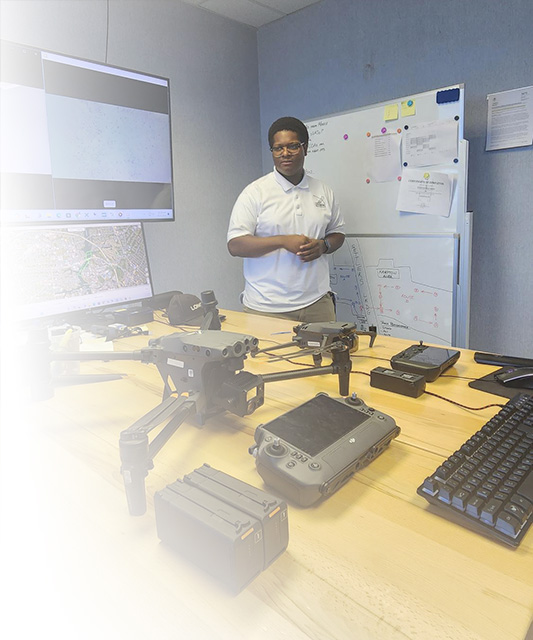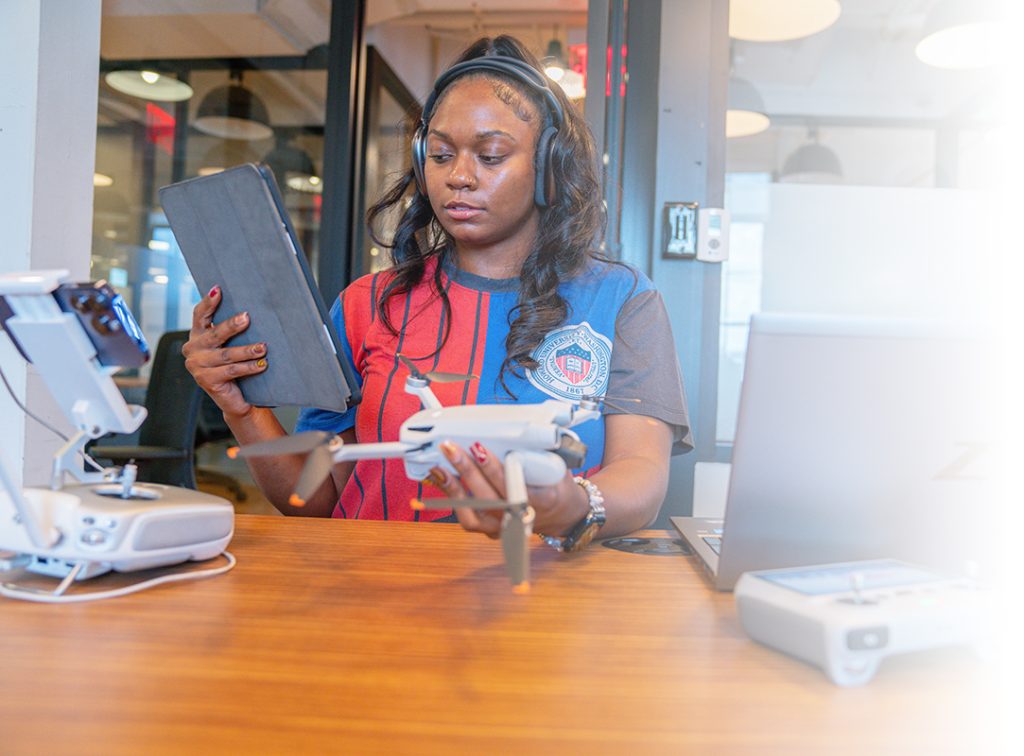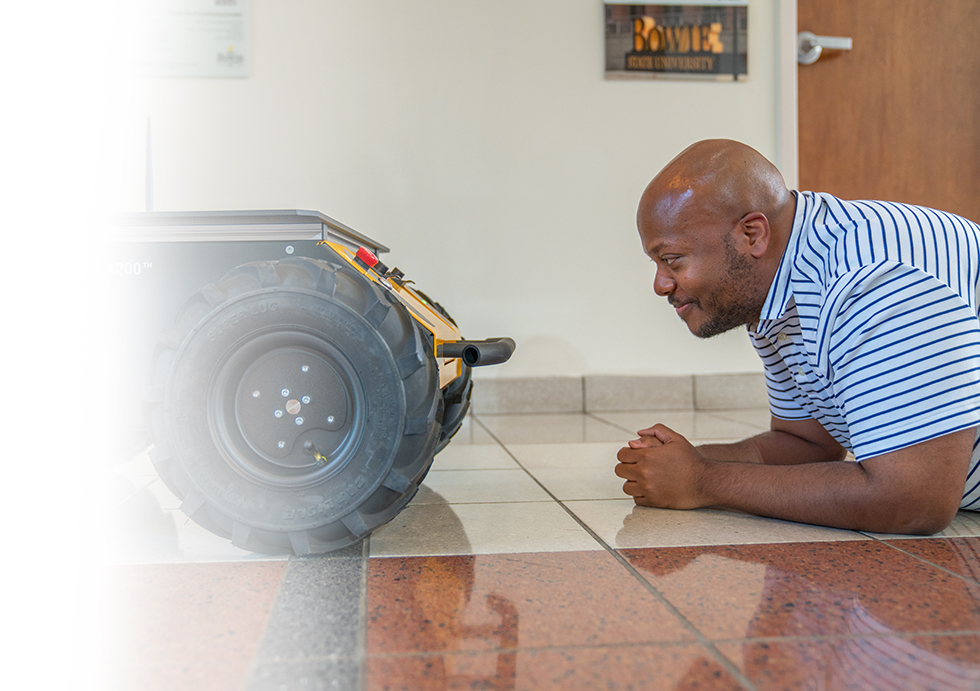RESEARCH


Our Vision
Our vision is to establish a globally recognized hub of excellence in autonomous systems research, where interdisciplinary collaboration catalyzes breakthroughs in technology, contributes to societal well-being, and shapes the future of autonomous applications.
‘Tactical Autonomy’ is defined as autonomous technology-based systems acting with delegated and bounded authority of humans in support of a strategic vision.
Our focus is on integrating applied research and development for new and existing US Department of War (DoW) capabilities and producing a larger workforce in tactical autonomy for the DoW.

Our Mission
The mission of the Research Institute For Tactical Autonomy (RITA) is to develop partnerships between academia, government, and industry to solve real-world tactical autonomy challenges and problems that are critical to our national security through systematic research and development.
We aim to:
- Pioneer transformative research and innovations in autonomy that bridge theoretical exploration with practical applications, thereby driving progress in technology, security, and sustainable development;
- Establish essential research and development capabilities for the Department of War to deliver operationally relevant autonomy by catalyzing community growth involving AI and autonomy research organizations;
- Accelerate RITA research and development by rapidly transferring its research to seed a unique science, research, and development ecosystem of small and large businesses, academia, and the Department of War;
- Transform AI and Autonomy practice throughout the government by creating innovative techniques, technologies, models, and tools that address critical challenges to meet mission outcomes and
- Grow the available pool of scientists and engineers to support the War Department and establish a source of organic technical and operational excellence.

Our Objective
The objective of the Tactical Autonomy UARC is to develop and demonstrate autonomous technologies that will enable various (AF)Air Force/(USSF) Space Force and Department of War (DoW) mission sets, with minimal supervision from human operators in environments that are complex and unpredictable with applications in Air, Space, Cyberspace, Ground and Sea.
Some areas of particular interest with respect to tactical autonomy and autonomous systems are:
-
- Enhance multi-domain situational awareness
- Reduce cognitive workload
- Enable force protection
- Support cyber defense
- Augment logistics
- Automate maneuverability and mobility

Trust in Mission Autonomy
Investigate and develop theoretical and practical techniques and technologies related to trust in mission autonomy to enable trusted and shared understanding in autonomous systems for complex, contested missions on the Multi-Domain Battlefield (MDB) at scale
Collaboration Between Platforms
Explore and develop theoretical and practical techniques and technologies related to collaboration between family of systems/platforms including human-machine collaborations, machine-machine collaborations by addressing challenges including interoperability, reliability, composability, complexity, and adaptability for Multi-Domain Battlefield MDB
Human Machine Teaming
Design, develop and implement theoretical and practical techniques and technologies related to Human-Machine teaming for enhanced maneuvering on the battlefield and trust, understanding, shared perception, joint reasoning, and adaptation to complex and contested MDB operating environments
Publications
2026
Causal Learning and Explainable AI (XAI) for Trustworthy Tactical Autonomy
Rawal, A., Ahmed, N. (2026). Causal learning and explainable AI (XAI) for trustworthy tactical autonomy. In H. Degen & S. Ntoa (Eds.), Artificial Intelligence in HCI, HCII 2026 (Lecture Notes in Computer Science). Springer, Cham. Affiliation: Research Institute For Tactical Autonomy (To appear).
Causal Learning & Explainable AI for Situational Awareness in Unmanned Aerial Systems
Rawal, A., & Ahmed, N. (2026). Causal learning and explainable AI for situational awareness in unmanned aerial systems. Proceedings of the 2026 IEEE Conference on Cognitive and Computational Aspects of Situation Management (CogSIMA), Tempe, AZ. Affiliation: Research Institute For Tactical Autonomy (To appear).
A Causal Explainability Framework for Trustworthy Mission Autonomy
Rawal, A., Ahmed, N. (2026). A Causal Explainability Framework for Trustworthy Mission Autonomy. Proceedings of 2026 SPIE Defense and Security - Assurance and Security for AI-enabled Systems. Affliation: Research Institute for Tactical Autonomy (To appear).
2025
A Hybrid DTN/NDN Middleware Gateway Controller for UAV Applications
Langrin, R., & Blackstone, J. (2025, October). A hybrid DTN/NDN middleware gateway controller for UAV applications. In Proceedings of the IEEE Military Communications Conference (MILCOM 2025), Workshop on Disruptive and Enabling Technologies for NATO and Other Coalition Operations, Los Angeles, CA. Affiliation: Howard University
2024
Iterated Crank–Nicolson Runge–Kutta Methods and Their Application to Wilson–Cowan Equations and Electroencephalography Simulations
Liu, J., Lu, Q., Boukari, H., & Boukari, F. (2024). Iterated Crank–Nicolson Runge–Kutta methods and their application to Wilson–Cowan equations and electroencephalography simulations. Foundations, 4(4), 673–689. Affiliation: Delaware State University.
Conferences and Presentations
2025
EEG Epoch Classification with Fourier Transform and LLM Transformer: Insights into Parkinson Disease.
Cooper, C., Lee, R., Feng, M., & Mao, J. (2025, April). EEG epoch classification with Fourier transform and LLM transformer: Insights into Parkinson disease. Abstract presented at the Emerging Researchers National (ERN) Conference in STEM, Atlanta, GA. Affiliation: Tougaloo College.
EEG Epoch Classification Using Fourier Transform and LLM Transformer: A Theoretical Approach.
Lee, R., Cooper, C., Feng, M., & Mao, J. (2025, April). EEG epoch classification using Fourier transform and LLM transformer: A theoretical approach. Abstract presented at the Emerging Researchers National (ERN) Conference in STEM, Atlanta, GA. Affiliation: Tougaloo College.
2024
The Power Analysis of Electroencephalogram Beta Rhythm for the Comparison of 432-Hz and 440-Hz Tuning on Music-Brain Interaction.
Mitchell, I., Liu, J., Boukari, F., & Lu, Q. (2024, November). The power analysis of electroencephalogram beta rhythm for the comparison of 432-Hz and 440-Hz tuning on music–brain interaction. Abstract presented at the APS Mid-Atlantic Section Meeting, November 2024. Affiliation: Delaware State University.


1328 Florida Ave NW, Washington, DC 20009
